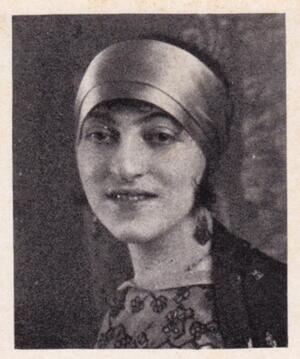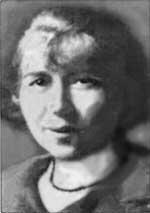Malka Lee
Malka Lee, in Korman's 1928 Yidishe Dikhterns Antologye.
Courtesy of Sheva Zucker/Lilith magazine.
During World War I, Malka Lee’s family fled from Galicia to Vienna. Lee immigrated to America in 1921, attending Hunter College and the Jewish Teachers Seminary. In the United States, Lee began writing in Yiddish rather than German, and her first published poetry appeared in 1922. She wrote six volumes of published poetry and contributed to Yiddish literary magazines and anthologies all over the world. Her early poems and essays explored her memories of Europe and the shtetls of her childhood, but her work after 1945 reflects her pain of observing the Holocaust, with its destruction of her family and childhood home, from the safety of distance in America. She published a memoir in 1955, and her later work expresses her Zionist devotion. With her husband, Lee managed a Yiddish writers’ colony in High Falls, New York.
Overview and Early Life
A writer of lyrical and sometimes sentimental poetry, Malka Lee was one of the most beloved female poets writing in Yiddish in America during her lifetime. Her poems had great folk appeal to Yiddish readers as reflections of their own experiences in the Old World and the New. Her work was favorably received by literary critics of the time, such as Shmuel Niger and Melech Ravitch. In 1965, she was awarded the Hayim Greenberg Award of Pioneer Women of America.
Born Malka Leopold on July 4, 1904, in the (Yiddish) Small-town Jewish community in Eastern Europe.shtetl of Monastrikh, Galicia, to Frieda (Duhl) and Chaim Leopold, Lee spent part of her youth in Vienna, where she fled with her family during World War I. After the war, she returned to Poland, only to immigrate to New York in 1921. In New York, she attended Hunter College and the Jewish Teachers Seminary.
As a young girl, Lee wrote her first poems in German, but in America she turned to Yiddish, her mother tongue, to write for people of her own background. Her first published poetry appeared in 1922, and she continued to contribute her works to Yiddish literary magazines and anthologies all over the world until her death in 1976.
Writing Career
A short autobiographic article published in July 1927 in the Yiddish newspaper Frayhayt was later expanded into a book of memoirs entitled Durkh Kindershe Oygn [Through the eyes of childhood] (1955) and dedicated to her family, shot by the Germans in Monastrikh in 1941. A portion of this work was translated into English in the book Found Treasures: Stories by Yiddish Women Writers (1994). Her other volume of prose, Mayselekh far Yoselen [Little stories for Yosel] (1969), is a book of short stories and fables for children.
Lee’s body of work, which includes six volumes of published poetry, is representative of an entire generation of Jewish women born and educated in Eastern Europe at the beginning of the twentieth century who found a very different life in America. Her early poetry intertwines the memories of shtetl life in a Hasidic family with the realities of the secular immigrant experience. Her volumes published between 1945 and 1950 reflect the personal pain of observing the Holocaust, with its destruction of family and childhood home, from the safety of distance in America. Her later work expresses a love of nature and her attachment to America, as well as her Zionist devotion to the State of Israel.
Lee and her first husband, writer Aaron Rappaport, owned and managed a bungalow colony in High Falls, New York, which became a haven for a coterie of Yiddish intellectuals based in New York. There she cultivated friendships with a variety of Yiddish writers and critics. After Rappaport’s death, she married Moshe Besser in 1966. Malka Lee, mother of Joseph Rappaport (b. 1924) and Yvette Rappaport (b. 1937), died in New York on March 22, 1976.
SELECTED WORKS BY MALKA LEE
“Am Yisroel Chai.” Text to music (1964).
Durkh Kindershe Oygn (1955).
Durkh Loytere Kvaln (1950).
Gezangen (1940).
In Likht fun Doyres (1961).
Kines fun Undzer Tsayt (1945).
Lider (1932).
Mayselekh far Yoselen (1969).
Untern Nusnboym (1969).
EJ (1972).
Forman, Frieda, Ethel Raicus, Sarah Silberstein Swartz, and Margie Wolfe, eds. Found Treasures: Short Stories by Yiddish Women Writers (1994).
Jonas-Maertin, Esther. "The Shtetl in New York: the poet Malka Lee." European Judaism 43.1 (Spring 2010).
Korman, Ezra, ed. Yidishe Dikhterins Antologye (1928).
Leksikon fun der Nayer Yidisher Literatur (1963).
Niger, Shmuel. Tsukunft (October 1932): 556+; Rappaport, Joseph [son]. Interview by author, NYC, July 30, 1995.
Ravitch, Melech. Meyn Leksikon. Vol. 2, bk. 4 (1948).
UJE.
Who’s Who in World Jewry (1965).




